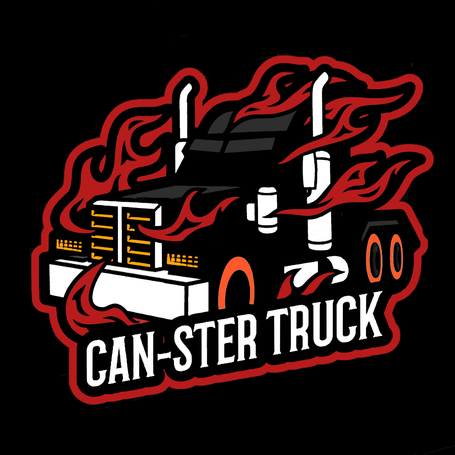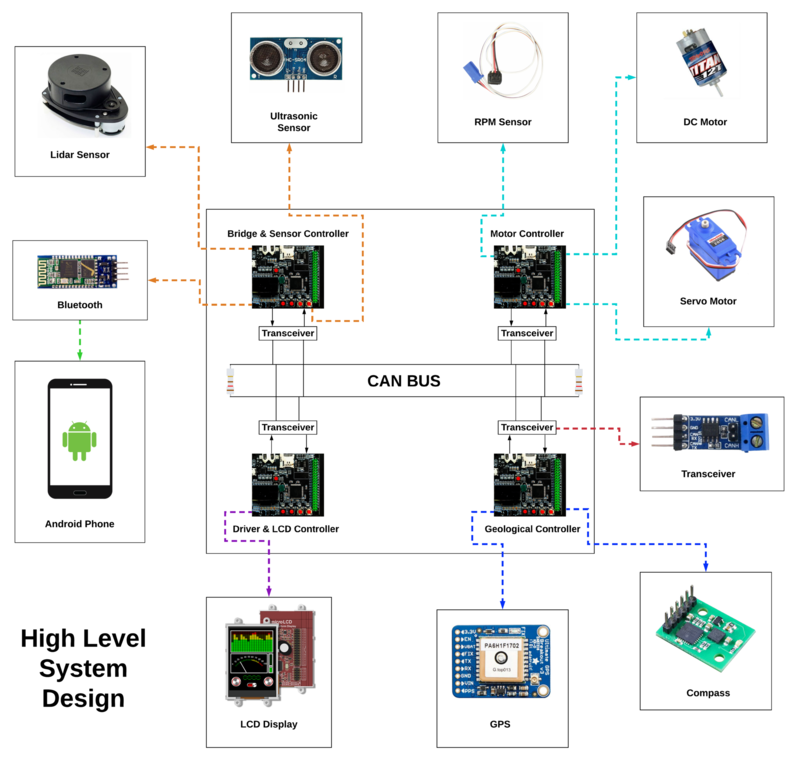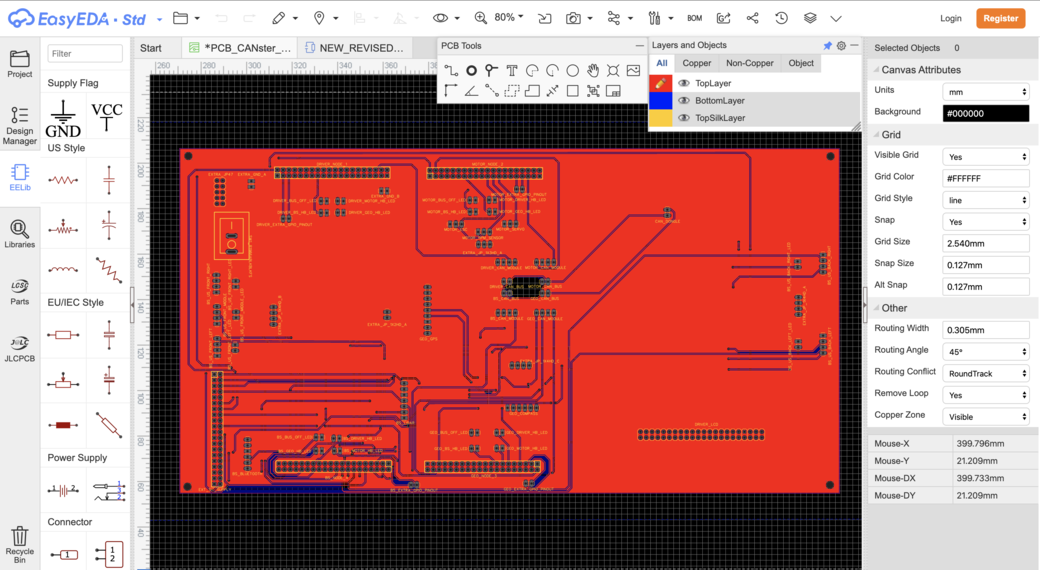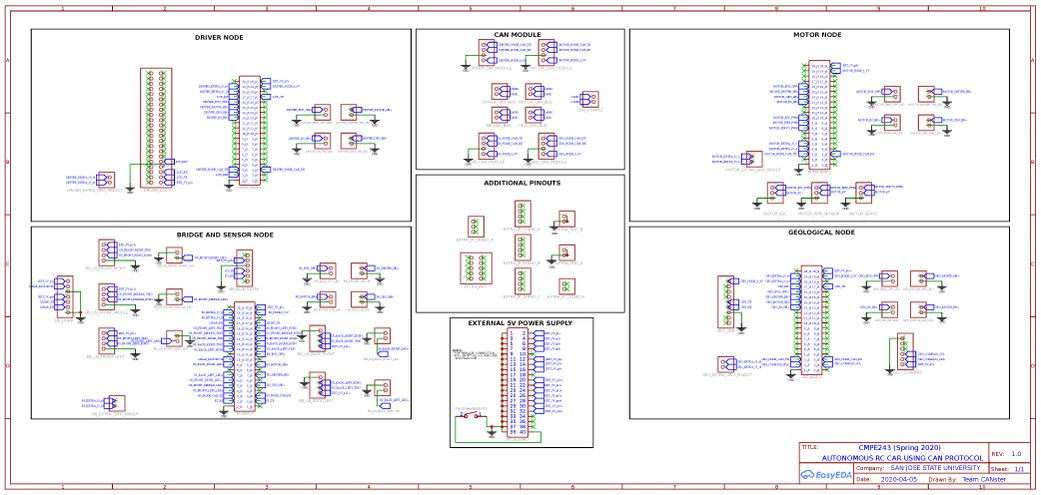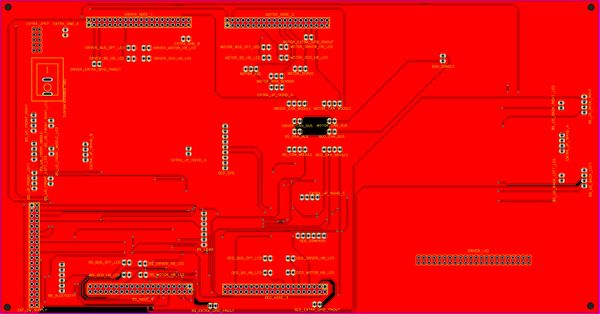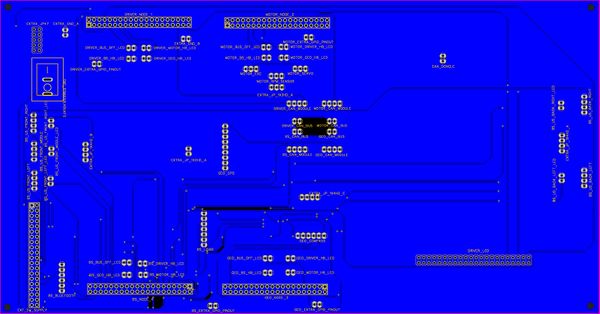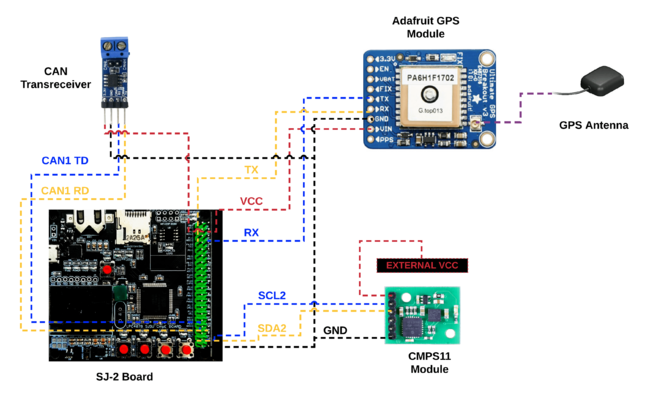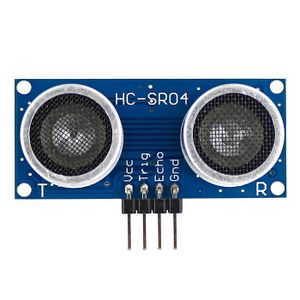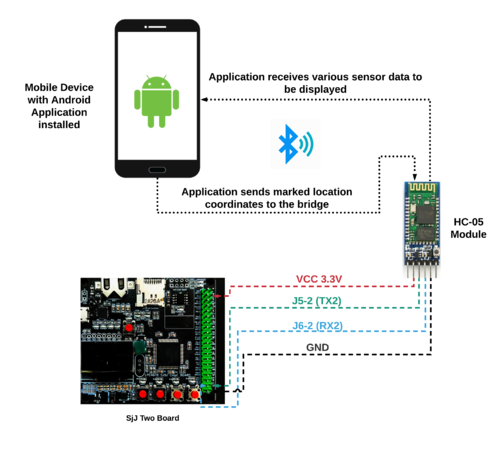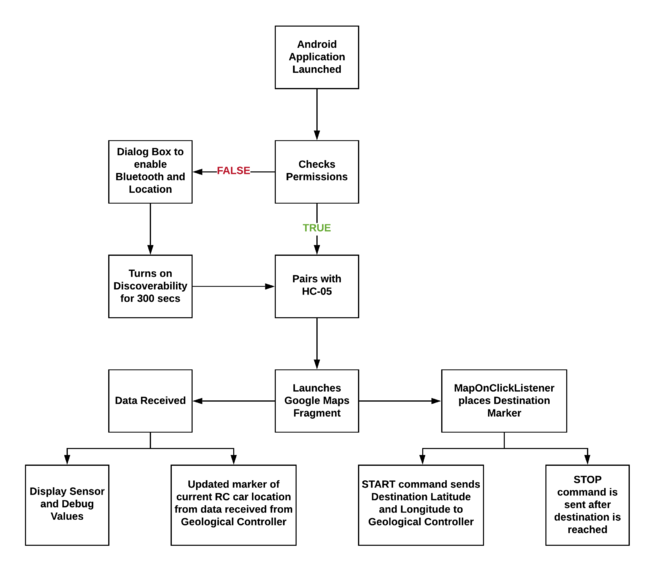Difference between revisions of "S20: Canster Truck"
(→Software Design) |
(→Software Design) |
||
| Line 839: | Line 839: | ||
** When the stop button is pressed, the stop command identifier is sent to the car, to stop and turn off the car. | ** When the stop button is pressed, the stop command identifier is sent to the car, to stop and turn off the car. | ||
*Info Activity: | *Info Activity: | ||
| + | ** Messages from Geological, Driver, Motor coming from CAN bus are decoded by the Sensor and Bridge controller and sent to the Android application as a string. | ||
| + | ** The received string is parsed and categorizes the data to store it in the required textView to be displayed. | ||
| + | ** Bluetooth status, Lidar Values, Ultrasonic Sensor Values, Motor Speed, Motor RPM, Motor PWM, Cars' current location, Compass Heading, Distance till Destination, Checkpoint Index is displayed for debugging purposes. | ||
*Debug Activity: | *Debug Activity: | ||
**The main function of this activity is to check all RAW RX and RAW TX messages and create a log of all the data received and sent. | **The main function of this activity is to check all RAW RX and RAW TX messages and create a log of all the data received and sent. | ||
Revision as of 16:03, 20 May 2020
Contents
- 1 Abstract
- 2 Introduction and Objectives
- 3 Team Members and Responsibilities
- 4 Administrative Responsibilities
- 5 Schedule
- 6 Bill Of Materials
- 7 Printed Circuit Board
- 8 CAN Communication
- 9 Motor Controller
- 10 Geological Controller
- 11 Sensor [Bridge and Sensor Controller]
- 12 Bridge [Bridge and Sensor Controller]
- 13 Ultrasonic Sensor
- 14 Driver [Driver and LCD Controller]
- 15 LCD [Driver and LCD Controller]
- 16 Android Application
- 17 Conclusion
- 18 References
Abstract
The Canster Truck Project is an autonomous RC car with CAN Bus interfaced controllers. The development of the RC car's subsystem modules (Interfacing of Ultrasonic Sensor, LIDAR, Bluetooth, GPS, Compass and CAN modules) was divided among six team members. The aim of the project is to develop an autonomous RC Car which can navigate from one source location to the selected destination on the app by avoiding obstacles in its path using sensors. Waypoints algorithm is used as the path finding technique.
Introduction and Objectives
The project was divided into 7 modules:
- Bridge and Sensor Controller
- Motor Controller
- Geological Controller
- Driver and LCD Controller
- Hardware Integration
- Android Application
- Testing & Code Review
RC Car Objectives
1. Driver and LCD Controller - Handles algorithms for obstacle avoidance, route maneuvering, and waypoints
2. Geological Controller - Recieves coordinates from GPS and Heading from Compass for navigation
3. Motor Controller - Controls movements of the RC Car
4. Bridge and Sensor Controller - Detects surrounding objects and interfaces android application to controller via bluetooth
Team Objectives
Team Members and Responsibilities
Gitlab Project Link - Canster Truck
- Niket Naidu LinkedIn Gitlab
- Geological Controller
- Driver and LCD Controller
- Testing & Code Review
- Android Application
- Ganesh Ram Pamadi LinkedIn Gitlab
- Hardware Integration
- Testing & Code Review
- Driver Controller
- Motor Controller
- Akhil Cherukuri LinkedIn Gitlab Github
- Android Application
- Geological Controller
- Hardware Integration
Administrative Responsibilities
- Team Lead - Niket Naidu
- Git Repository Manager - Niket Naidu
- Bill Of Materials Manager - Akhil Cherukuri
- Wiki Report Manager - Akhil Cherukuri
Schedule
| Week# | Start Date | End Date | Task | Status |
|---|---|---|---|---|
| 1 | 02/11/2020 | 02/17/2020 |
|
|
| 2 | 02/18/2020 | 02/24/2020 |
|
|
| 3 | 02/25/2020 | 03/02/2020 |
|
|
| 4 | 03/03/2020 | 03/09/2020 |
|
|
| 5 | 03/10/2020 | 03/16/2020 |
|
|
| 6 | 03/17/2020 | 03/23/2020 |
|
|
| 7 | 03/24/2020 | 03/30/2020 |
|
|
| 8 | 03/31/2020 | 04/06/2020 |
|
|
| 9 | 04/07/2020 | 04/13/2020 |
|
|
| 10 | 04/14/2020 | 04/20/2020 |
|
|
| 11 | 04/21/2020 | 04/27/2020 |
|
|
| 12 | 04/28/2020 | 05/04/2020 |
|
|
| 13 | 05/05/2020 | 05/21/2020 |
|
|
Bill Of Materials
| Item# | Part Description | Part Model & Vendor | Quantity | Cost in USD |
|---|---|---|---|---|
| 1 | Microcontroller Boards | SJ2 Boards (Purchased from Preet Kang) | 4 | $200.00 |
| 2 | CAN Transceivers | Waveshare SN65HVD230 | 12 | $54.48 |
| 3 | RC Car | Traxxas 2WD RTR with 2.4Ghz Radio | 1 | $260.00 |
| 4 | Lithium-Ion Battery | Traxxas 7600mAh 2S 7.4V 25C iD LiPo Battery Pack | 1 | $75.00 |
| 5 | Lithium-Ion Battery Charger | Traxxas 2970 EZ-Peak Plus 4-Amp NiMH/LiPo Fast Charger | 1 | $50.00 |
| 6 | Compass Breakout Board | DFRobot CMPS11 Compass | 1 | $29.99 |
| 7 | Bluetooth Breakout Board | DSD TECH Bluetooth HC-05 | 1 | $8.49 |
| 8 | LIDAR Sensor | SEEED STUDIO RPLIDAR A1M8 | 1 | $109.99 |
| 9 | RPM Sensor | Traxxas 6520 RPM Sensor | 1 | $13.70 |
| 10 | GPS Breakout Board | Adafruit Ultimate GPS Breakout v3 | 1 | $44.30 |
| 11 | LCD Display | 4Dsystems 3.2 TFT-LCD ULCD-32PTU | 1 | $79.00 |
| 12 | Ultrasonic Sensors | ELEGOO HC-SR04 Ultrasonic Module | 5 | $12.00 |
| 13 | GPS Antenna | GPS Antenna A1-UX | 1 | $10.98 |
| 14 | PCB Fabrication | JLCPCB | 5 | $40.15 |
| 15 | Miscellaneous | Amazon,Mouser Electronics,Digikey,Anchor Electronics | ~ | $48.07 |
| Total | $1036.15 |
Printed Circuit Board
Design And Architecture
The complete PCB (for boards and hardware peripherals) was designed using EasyEDA online software. The 4 nodes will be communicating via CAN bus and other peripherals are connected to the PCB via headers.
Power Section
We have 2 power banks supplying our system. And the Servo Motor, RPM sensor and DC rear Motor (via ESC) are powered using LiPo battery (6 volts).
- Power bank #1 - Subset 2
- Power bank #2 - Subset 1, Subset 3, Bluetooth
NOTE:
Subset 1:
1. LIDAR 2. LCD 3. Compass
Subset 2:
1. Motor node 2. Driver node 3. BS node
Subset 3:
1. Geo node 2. Back ultrasonic sensor
Fabrication
- PCB was sent to fabrication to JLCPCB China which provided PCB with MOQ of 5 and 2 layers of PCB with common grounded the entire copper area.
DRC elements
- Track Width = 12
- Clearance = 10
- Via Diameter = 24
- Via Drill Diameter = 12
Challenges
- Auto-routing gave lot of challenges (only ~60% success) and sometimes the online server even crashes and faces downtime. Even local routing had lot of issues. So make sure to plan your design accordingly.
- We started our PCB design well ahead of the project. So lot of pre-planning had to be done with regard to final hardware and placement of components in order to avoid spending extra time and money while re-ordering.
- The PCB went through a lot of internal revisions even before placing order. This was time-consuming.
CAN Communication
<Talk about your message IDs or communication strategy, such as periodic transmission, MIA management, etc.>
Hardware Design
<Show your CAN bus hardware design>
DBC File
DBC FILE: Gitlab
VERSION "" NS_: BA_ BA_DEF_ BA_DEF_DEF_ BA_DEF_DEF_REL_ BA_DEF_REL_ BA_DEF_SGTYPE_ BA_REL_ BA_SGTYPE_ BO_TX_BU_ BU_BO_REL_ BU_EV_REL_ BU_SG_REL_ CAT_ CAT_DEF_ CM_ ENVVAR_DATA_ EV_DATA_ FILTER NS_DESC_ SGTYPE_ SGTYPE_VAL_ SG_MUL_VAL_ SIGTYPE_VALTYPE_ SIG_GROUP_ SIG_TYPE_REF_ SIG_VALTYPE_ VAL_ VAL_TABLE_ BS_: BU_: DBG DRIVER IO MOTOR SENSOR GEO BO_ 100 DRIVER_HEARTBEAT: 1 DRIVER SG_ DRIVER_HEARTBEAT_cmd: 0|8@1+ (1,0) [0|0] "" GEO,MOTOR,SENSOR BO_ 101 GEO_HEARTBEAT: 1 GEO SG_ GEO_HEARTBEAT_cmd: 0|8@1+ (1,0) [0|0] "" DRIVER,MOTOR,SENSOR BO_ 102 MOTOR_HEARTBEAT: 1 MOTOR SG_ MOTOR_HEARTBEAT_cmd: 0|8@1+ (1,0) [0|0] "" DRIVER,GEO,SENSOR BO_ 103 SENSOR_HEARTBEAT: 1 SENSOR SG_ SENSOR_HEARTBEAT_cmd: 0|8@1+ (1,0) [0|0] "" DRIVER,GEO,MOTOR BO_ 200 MOTOR_STEERING: 1 DRIVER SG_ MOTOR_STEERING_direction: 0|8@1- (1,0) [-2|2] "" MOTOR BO_ 210 DRIVER_COORDINATES: 8 DRIVER SG_ DRIVER_COORDINATES_latitude: 0|32@1- (0.000001,-90) [-90|90] "degrees" GEO SG_ DRIVER_COORDINATES_longitude: 32|32@1- (0.000001,-180) [-180|180] "degrees" GEO BO_ 220 MOTOR_SPEED: 1 DRIVER SG_ MOTOR_SPEED_processed: 0|8@1- (1,0) [-3|3] "" MOTOR BO_ 300 GEO_DEGREE: 8 GEO SG_ GEO_DEGREE_current: 0|32@1+ (0.000001,0) [0|360] "degrees" DRIVER SG_ GEO_DEGREE_required: 32|32@1+ (0.000001,0) [0|360] "degrees" DRIVER BO_ 310 GEO_DESTINATION_REACHED: 1 GEO SG_ GEO_DESTINATION_REACHED_cmd: 0|8@1+ (1,0) [0|0] "" DRIVER BO_ 400 MOTOR_SPEED_FEEDBACK: 4 MOTOR SG_ MOTOR_SPEED_current: 0|32@1+ (0.1,0) [0|60] "kph" DRIVER BO_ 500 SENSOR_BT_COORDINATES: 8 SENSOR SG_ SENSOR_BT_COORDINATES_latitude: 0|32@1- (0.000001,-90) [-90|90] "degrees" GEO SG_ SENSOR_BT_COORDINATES_longitude: 32|32@1- (0.000001,-180) [-180|180] "degrees" GEO BO_ 510 SENSOR_SONARS: 8 SENSOR SG_ SENSOR_SONARS_left: 0|21@1+ (0.001,0) [0|0] "cm" DRIVER SG_ SENSOR_SONARS_right: 21|21@1+ (0.001,0) [0|0] "cm" DRIVER SG_ SENSOR_SONARS_middle: 42|21@1+ (0.001,0) [0|0] "cm" DRIVER BO_ 520 SENSOR_LIDAR: 8 SENSOR SG_ SENSOR_LIDAR_middle: 0|16@1+ (1,0) [0|0] "cm" DRIVER SG_ SENSOR_LIDAR_slight_left: 16|16@1+ (1,0) [0|0] "cm" DRIVER SG_ SENSOR_LIDAR_slight_right: 32|16@1+ (1,0) [0|0] "cm" DRIVER SG_ SENSOR_LIDAR_back: 48|16@1+ (1,0) [0|0] "cm" DRIVER BO_ 530 MOTOR_KEY: 1 SENSOR SG_ MOTOR_KEY_val: 0|8@1+ (1,0) [0|0] "" DRIVER BO_ 900 GEO_CURRENT_COORDINATES: 8 GEO SG_ GEO_CURRENT_COORDINATES_latitude: 0|32@1- (0.000001,-90) [-90|90] "degrees" DBG SG_ GEO_CURRENT_COORDINATES_longitude: 32|32@1- (0.000001,-180) [-180|180] "degrees" DBG BO_ 901 GEO_DISTANCE_FROM_DESTINATION: 4 GEO SG_ GEO_distance_from_destination: 0|32@1+ (0.001,0) [0|0] "meters" DBG BO_ 902 MOTOR_INFO_DBG: 4 MOTOR SG_ MOTOR_INFO_DBG_rps: 0|16@1+ (1,0) [0|0] "" DBG SG_ MOTOR_INFO_DBG_pwm: 16|16@1+ (0.001,0) [0|0] "" DBG BO_ 903 LIPO_BATTERY_VOLTAGE_DBG: 4 MOTOR SG_ LIPO_BATTERY_VOLTAGE_val: 0|32@1+ (0.01,0) [0|0] "volts" DBG BO_ 904 CURRENT_CHECKPOINT_DBG: 1 GEO SG_ CURRENT_CHECKPOINT_val: 0|8@1+ (1,0) [0|0] "" DBG CM_ "--BU (Network Node) Information--"; CM_ BU_ DRIVER "The driver controller of the car"; CM_ BU_ GEO "The geo controller of the car"; CM_ BU_ MOTOR "The motor controller of the car"; CM_ BU_ SENSOR "The sensor controller of the car"; CM_ "--BO (Message) Information--"; CM_ BO_ 100 "Driver Sync message used to synchronize the controllers"; CM_ BO_ 101 "Geo Sync message used to synchronize the controllers"; CM_ BO_ 102 "Motor Sync message used to synchronize the controllers"; CM_ BO_ 103 "Sensor Sync message used to synchronize the controllers"; CM_ BO_ 200 "Steering direction values sent by Driver Node to Motor Node"; CM_ BO_ 210 "Driver Destination coordinates sent by Driver Node"; CM_ BO_ 220 "Required motor speed computed from Driver Node to Motor Node"; CM_ BO_ 300 "Current and computer/required degree values sent by Geo Node"; CM_ BO_ 310 "Indicator signal to check if the RC car has reached the destination"; CM_ BO_ 400 "Current motor info (rps and kph) sent as feedback to the Driver Node"; CM_ BO_ 500 "Coordinate BT values (destination coordinates) sent by Sensor Node"; CM_ BO_ 510 "LIDAR - Distance from obstacle detected in each sector"; CM_ BO_ 520 "Ultrasonic Sensor - Distance from obstacle detected by each sensor"; CM_ BO_ 530 "Start/Stop signal from the Bluetooth app"; CM_ BO_ 900 "Destination coordinates for BUSMASTER debugging"; CM_ BO_ 901 "Distance from destination"; CM_ BO_ 902 "Supplied PWM value to the motor and its RPM"; CM_ BO_ 903 "LIPO Battery Voltage"; CM_ BO_ 904 "Current checkpoint of the car"; CM_ "--SG (Signal) Information for Heartbeats--"; CM_ SG_ 100 DRIVER_HEARTBEAT_cmd "Heartbeat command from the driver node"; CM_ SG_ 101 GEO_HEARTBEAT_cmd "Heartbeat command from the geological node"; CM_ SG_ 102 MOTOR_HEARTBEAT_cmd "Heartbeat command from the motor node"; CM_ SG_ 103 SENSOR_HEARTBEAT_cmd "Heartbeat command from the sensor node"; CM_ "--SG (Signal) Information for DRIVER Node--"; CM_ SG_ 200 DRIVER_STEERING_direction "Calculated Driver Steering values (-2,2) for Motor"; CM_ SG_ 210 DRIVER_COORDINATES_latitude "Destination Latitude coordinate"; CM_ SG_ 210 DRIVER_COORDINATES_longitude "Destination Longitude coordinate"; CM_ SG_ 220 MOTOR_SPEED "Calculated Driver speed values (-3,3) for Motor"; CM_ "--SG (Signal) Information for GEO Node--"; CM_ SG_ 300 GEO_DEGREE_current "Current Geo Degree relative to true north"; CM_ SG_ 300 GEO_DEGREE_required "Calculated Geo Degree computed by Haversine Formula"; CM_ SG_ 310 GEO_DESTINATION_REACHED "Indicator signal to check if the RC car has reached the destination"; CM_ "--SG (Signal) Information for MOTOR Node--"; CM_ SG_ 400 MOTOR_SPEED_FEEDBACK "Feedback speed (kph) sent by Motor Node"; CM_ "--SG (Signal) Information for SENSOR Node--"; CM_ SG_ 500 SENSOR_BT_COORDINATES_latitude "Destination Latitude received over Bluetooth"; CM_ SG_ 500 SENSOR_BT_COORDINATES_longitude "Destination Longitude received over Bluetooth"; CM_ SG_ 510 SENSOR_SONARS_left "Ultrasonic Sensor attached to the left side"; CM_ SG_ 510 SENSOR_SONARS_right "Ultrasonic Sensor attached to the right side"; CM_ SG_ 510 SENSOR_SONARS_middle "Ultrasonic Sensor attached to the middle"; CM_ SG_ 510 SENSOR_SONARS_back_left "Ultrasonic Sensor attached to the back left side"; CM_ SG_ 510 SENSOR_SONARS_back_right "Ultrasonic Sensor attached to the back right side"; CM_ SG_ 520 SENSOR_LIDAR_middle "Lidar sensing the middle sector (-15 to 15 degrees)"; CM_ SG_ 520 SENSOR_LIDAR_slight_left "Lidar sensing the slight left sector (-45 to -15 degrees)"; CM_ SG_ 520 SENSOR_LIDAR_slight_right "Lidar sensing the slight right sector (15 to 45 degrees)"; CM_ SG_ 520 SENSOR_LIDAR_back "Lidar sensing the back of the car (165 to 195 degrees)"; CM_ SG_ 530 MOTOR_KEY_val "1 -> Start the motor from the app, 0 -> Stop"; CM_ SG_ 900 GEO_CURRENT_COORDINATES_latitude "Current Latitude"; CM_ SG_ 900 GEO_CURRENT_COORDINATES_longitude "Current Longitude"; CM_ SG_ 901 GEO_distance_from_destination "Distance from destination"; CM_ SG_ 902 MOTOR_INFO_DBG_rps "Current RPS value of the motor"; CM_ SG_ 902 MOTOR_INFO_DBG_pwm "Supplied motor PWM value"; CM_ SG_ 903 LIPO_BATTERY_VOLTAGE_val "LIPO Battery Voltage"; CM_ SG_ 904 CURRENT_CHECKPOINT_val "Current checkpoint of the car"; BA_DEF_ "BusType" STRING ; BA_DEF_ BO_ "GenMsgCycleTime" INT 0 0; BA_DEF_ SG_ "FieldType" STRING ; BA_DEF_DEF_ "BusType" "CAN"; BA_DEF_DEF_ "FieldType" ""; BA_DEF_DEF_ "GenMsgCycleTime" 0; BA_ "GenMsgCycleTime" BO_ 100 1000; BA_ "GenMsgCycleTime" BO_ 200 50; BA_ "FieldType" SG_ 100 DRIVER_HEARTBEAT_cmd "DRIVER_HEARTBEAT_cmd"; BA_ "FieldType" SG_ 102 GEO_HEARTBEAT_cmd "GEO_HEARTBEAT_cmd"; BA_ "FieldType" SG_ 103 MOTOR_HEARTBEAT_cmd "MOTOR_HEARTBEAT_cmd"; BA_ "FieldType" SG_ 104 SENSOR_HEARTBEAT_cmd "SENSOR_HEARTBEAT_cmd"; BA_ "FieldType" SG_ 200 MOTOR_STEERING "MOTOR_STEERING"; BA_ "FieldType" SG_ 230 MOTOR_SPEED_val "MOTOR_SPEED_val"; BA_ "FieldType" SG_ 310 GEO_DESTINATION_REACHED_cmd "GEO_DESTINATION_REACHED_cmd"; VAL_ 100 DRIVER_HEARTBEAT_cmd 2 "DRIVER_HEARTBEAT_cmd_REBOOT" 1 "DRIVER_HEARTBEAT_cmd_SYNC" 0 "DRIVER_HEARTBEAT_cmd_NOOP" ; VAL_ 101 GEO_HEARTBEAT_cmd 2 "GEO_HEARTBEAT_cmd_REBOOT" 1 "GEO_HEARTBEAT_cmd_SYNC" 0 "GEO_HEARTBEAT_cmd_NOOP"; VAL_ 102 MOTOR_HEARTBEAT_cmd 20 "MOTOR_HEARTBEAT_cmd_REBOOT" 10 "MOTOR_HEARTBEAT_cmd_SYNC" 0 "MOTOR_HEARTBEAT_cmd_NOOP" ; VAL_ 103 SENSOR_HEARTBEAT_cmd 200 "SENSOR_HEARTBEAT_cmd_REBOOT" 100 "SENSOR_HEARTBEAT_cmd_SYNC" 0 "SENSOR_HEARTBEAT_cmd_NOOP" ; VAL_ 200 MOTOR_STEERING_direction -2 "MOTOR_STEERING_hard_left" -1 "MOTOR_STEERING_slight_left" 0 "MOTOR_STEERING_straight" 1 "MOTOR_STEERING_slight_right" 2 "MOTOR_STEERING_hard_right"; VAL_ 220 MOTOR_SPEED_processed -3 "MOTOR_SPEED_reverse_fast" -2 "MOTOR_SPEED_reverse_medium" -1 "MOTOR_SPEED_reverse_slow" 0 "MOTOR_SPEED_neutral" 1 "MOTOR_SPEED_forward_slow" 2 "MOTOR_SPEED_forward_medium" 3 "MOTOR_SPEED_forward_fast"; VAL_ 310 GEO_DESTINATION_REACHED_cmd 1 "GEO_DESTINATION_REACHED_cmd_REACHED" 0 "GEO_DESTINATION_REACHED_cmd_NOT_REACHED";
Motor Controller
<Picture and link to Gitlab>
Hardware Design
Software Design
<List the code modules that are being called periodically.>
Technical Challenges
< List of problems and their detailed resolutions>
Geological Controller
<Picture and link to Gitlab>
Hardware Design
Software Design
<List the code modules that are being called periodically.>
Technical Challenges
< List of problems and their detailed resolutions>
Sensor [Bridge and Sensor Controller]
<Picture and link to Gitlab>
Hardware Design
Software Design
<List the code modules that are being called periodically.>
Technical Challenges
< List of problems and their detailed resolutions>
Bridge [Bridge and Sensor Controller]
<Picture and link to Gitlab>
Bridge functionality of the Bridge and Sensor Controller is to establish wireless communication between the SJ-2 Board and the android mobile device using the HC-05 Bluetooth module. The Bridge controller will be receiving start command with destination GEO coordinates and stop command. The Bridge controller will be transmitting the required sensor data and debug information to be displayed on the android application.
Ultrasonic Sensor
Hardware Design
This sensor uses ultrasonic beam to measure the distances. Based on the time taken between when the beam is sent and received back to the sensor, the distance is calculated in the node. Apart from 5v and GND, this sensor has 2 pins ECHO and TRIG which are interfaced to the SJ-Two board via GPIO.
Software Design
- Init the GPIO pin connected to TRIG of the sensor as output and for ECHO as input port.
- Attach the interrupt on the ECHO input port.
- Store the system_clock_count before setting the trigger pulse and then set the pulse. Also keep monitoring the input port.
- Take the system_clock_count at the instant of receiving the interrupt.
Distance = (system_clock_count_at_trig - system_clock_count_after_at_echo) / 57.14
Software Design
<List the code modules that are being called periodically.>
Technical Challenges
<List of problems and their detailed resolutions>
Driver [Driver and LCD Controller]
<Picture and link to Gitlab>
Hardware Design
Software Design
<List the code modules that are being called periodically.>
Technical Challenges
< List of problems and their detailed resolutions>
LCD [Driver and LCD Controller]
<Picture and link to Gitlab>
Hardware Design
Software Design
<List the code modules that are being called periodically.>
Technical Challenges
< List of problems and their detailed resolutions>
Android Application
Software Design
The application consists of a total of 5 Activities:
- Main Activity:
- This is the app launch display screen
- It will check for all the required permission onStart().
- Has search button for connecting from a paired device list view
- Once device is clicked, an intent will start the Map Activity
- Map Activity:
- For this requirement we are using the Google Maps Fragment, for the map fragment to function we must request an API key from Google and set the key in the manifest of the application.
- Destination marker(Red Marker) is set using setOnMapClickListener to which the car will navigate to, the destination can be changed by clicking elsewhere on the Map Fragment. The marker can be removed using setOnMarkerClickListener.
- When the start button is pressed, the start command identifier along with destination latitude and longitude is sent to the car via the write thread. A background thread is started along with it to indicate the current car's position(Green Marker) along with a plotline between the current position and destination.
- When the stop button is pressed, the stop command identifier is sent to the car, to stop and turn off the car.
- Info Activity:
- Messages from Geological, Driver, Motor coming from CAN bus are decoded by the Sensor and Bridge controller and sent to the Android application as a string.
- The received string is parsed and categorizes the data to store it in the required textView to be displayed.
- Bluetooth status, Lidar Values, Ultrasonic Sensor Values, Motor Speed, Motor RPM, Motor PWM, Cars' current location, Compass Heading, Distance till Destination, Checkpoint Index is displayed for debugging purposes.
- Debug Activity:
- The main function of this activity is to check all RAW RX and RAW TX messages and create a log of all the data received and sent.
- Bluetooth Connection Service Activity :
- This is the background activity that handles all the threads required for transmission and receiving data using Bluetooth connections. It has 3 running threads which is called inside other activities using a handler:
- Accept Thread - Listens to BluetoothServerSocket using listenUsingRfcommWithServiceRecord. In order for the RF communication socket to connect to the HC-05, we used the following UUID: 00001101-0000-1000-8000-00805F9B34FB. This is a generic SSP Bluetooth UUID that enables the socket to directly connected to HC-05 and maintain the connection.
- Connect Thread - Creates a Bluetooth socket using createRfcommSocketToServiceRecord
- Connected Thread - Creates socket.getInputStream(); and socket.getOutputStream(); when bytes are available in input stream it will read them into a buffer.
- All messages for activities are done by Handler mHandler.obtainMessage(); mHandler.sendMessage();
- Receieved string:
- A String is sent to the Bluetooth app from HC-05 and when it receives a string with identifier "$canster", the message is prased accordingly by using the string delimiter ',' and is ended by the newline character '\n' which will remove the data from StringBuffer.
- Example: $canster,37.339334,-121.881123,37.338713,-121.880685,10.123,20.133,30.123,10.5,88.1,99.2,-2,1,44,7,11,22,33,-3,23\n
<List the code modules that are being called periodically.>
Technical Challenges
Other hardware challenges:
- Figuring out why various hardware peripherals (GPS, Bluetooth, LIDAR and Ultrasonic sensor) started to malfunction (devices were on but values were either inconsistent / not occurring), took a lot of time to debug. It was due to insufficient power.
Conclusion
CMPE243 gives one of the best experiences one could ever get in their academic life. The course is designed to give an insight into how the industry functions and enhances both technical and management skills. Apart from learning how to work and implement application of CAN protocol, one can get a hands-on experience with version control, unit-testing and software design. Overall it was a very great journey.
Project Video
Project Source Code
Advise for Future Students
GENERAL:
- Form your team and start the project as early as you can.
- Clearly discuss what role each individual should do and ensure that progress is regularly tracked so that the team doesn't fall back on any schedule.
- Since lot of code and hardware integration is involved with this project, make sure testing is thoroughly and periodically done and make note of all the issues found.
HARDWARE:
- Decide on how you would power up the peripherals. We had issues with Bluetooth (not connecting), GPS (lock not happening) and LIDAR (giving incorrect values). After lot of cycles of hardware and software debugging, we found that the issue was with power. Choose wisely as to which peripherals must be connected to which power bank.
- PCB design is time consuming as there is a lot of hardware components involved and a huge responsibility falls on the designer to know the about each component. Coordinating with multiple team members and verifying with them if their respective hardware is correct takes a lot of time. So start well ahead.
- Make sure to expose some extra GPIO and GND pins for future use.
Acknowledgement
Firstly we would like to express our gratitude to Professor Preetpal Kang for his guidance throughout the semester and providing us with this opportunity. We would also like to thank the ISA members Vignesh Kumar Venkateshwar and Aakash Vrajlal Chitroda for being available whenever in need and guiding us to complete the project.
References
Motor Controller
Geological Controller
Bridge and Sensor Controller
Driver and LCD Controller
Android
- Youtube Channel: Coding with Mitch
- Android Developers: WebsiteGithub
- Udemy Course: Complete Android Oreo Developer Course
PCB Design
- EDC Tool: EasyEDA
